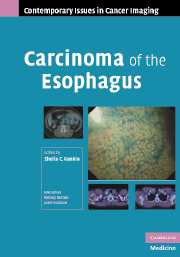Book contents
- Frontmatter
- Contents
- Contributors
- Series foreword
- Preface to Carcinoma of the Esophagus
- 1 Epidemiology and Clinical Presentation in Esophageal Cancer
- 2 Pathology of Esophageal Cancer
- 3 Recent Advances in the Endoscopic Diagnosis of Esophageal Cancer
- 4 Endoscopic Ultrasound in Esophageal Cancer
- 5 CT in Esophageal Cancer
- 6 FDG-PET and PET/CT in Esophageal Cancer
- 7 The Role of Surgery in the Management of Esophageal Cancer and Palliation of Inoperable Disease
- 8 Chemotherapy and Radiotherapy in Esophageal Cancer
- 9 Role of Stents in the Management of Esophageal Cancer
- 10 Lasers in Esophageal Cancer
- Index
- References
3 - Recent Advances in the Endoscopic Diagnosis of Esophageal Cancer
Published online by Cambridge University Press: 08 August 2009
- Frontmatter
- Contents
- Contributors
- Series foreword
- Preface to Carcinoma of the Esophagus
- 1 Epidemiology and Clinical Presentation in Esophageal Cancer
- 2 Pathology of Esophageal Cancer
- 3 Recent Advances in the Endoscopic Diagnosis of Esophageal Cancer
- 4 Endoscopic Ultrasound in Esophageal Cancer
- 5 CT in Esophageal Cancer
- 6 FDG-PET and PET/CT in Esophageal Cancer
- 7 The Role of Surgery in the Management of Esophageal Cancer and Palliation of Inoperable Disease
- 8 Chemotherapy and Radiotherapy in Esophageal Cancer
- 9 Role of Stents in the Management of Esophageal Cancer
- 10 Lasers in Esophageal Cancer
- Index
- References
Summary
Introduction
Esophageal cancer is the seventh most common malignancy worldwide and has the sixth highest cancer mortality rate. It has one of the most rapidly increasing incidence of all cancers in the last 5 years and is associated with a poor 1 and 5-year survival in the UK.
Correct staging of esophageal cancer is essential for patient care. This not only gives a good indication of survival but also allows for optimum management of the patient. In patients with very early oesophageal cancer (Tis/T1m), local treatment with endoscopic mucosal resection (EMR) or photodynamic therapy can be considered. For those patients with more advanced disease (Stages IIB–III), many centers now advocate using neoadjuvant chemotherapy (OEO2) or chemoradiotherapy prior to surgery as this may improve survival. For those patients with metastatic disease (Stage IV), palliative treatment is appropriate.
Endoscopic imaging
Flexible videoendoscopy with biopsy and/or brush cytology is the gold standard investigation for the diagnosis of esophageal carcinoma. Endoscopy is more sensitive and specific than double-contrast barium meal for the diagnosis of upper gastrointestinal cancer, and when biopsy and cytology are combined, the accuracy of endoscopy for diagnosis approaches 100%. Rarely, in patients with pseudoachalasia and repeated negative mucosal biopsy, endoscopic ultrasound with or without fine-needle aspiration biopsy may provide supportive evidence for malignancy and a tissue diagnosis.
- Type
- Chapter
- Information
- Carcinoma of the Esophagus , pp. 28 - 43Publisher: Cambridge University PressPrint publication year: 2007



